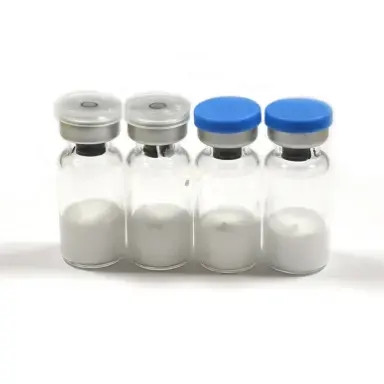
Studies suggest this peptide is an analog of Selank, a possibly powerful peptide with nootropic and anxiety-reducing potential. Researchers anticipate the following properties from the proposed changes, which aim to enhance the peptide's pharmacokinetics:
Impact on cognition
Impact on anxiety/stress hormone release
Impact on inflammation
N-Acetyl Selank Amidate: What Is It?
The nootropic peptide Selank has been modified by acetylation and amidation to become N-Acetyl Selank Amidate. The C-terminal amino acid residue threonine of the tetrapeptide tuftsin is present in both peptides. Further modifications to N-Acetyl Selank Amidate are believed to strengthen the peptide and prevent its N- and C-terminal groups from hydrolyzing. The heptapeptide N-Acetyl Selank Amidate may cross the blood-brain barrier (BBB) and has improved stability.
While Selank has been used in the context of GAD since 2009 and is being studied for its possible potential on cognition, neuroprotection, and immunomodulation, N-Acetyl Selank Amidate has not yet been included in any studies. It is believed that N-Acetyl Selank Amidate, a modified peptide, may have the same properties with better pharmacokinetics.
N-Acetyl Selank Amidate: Mechanism of Action
- Long COVID's link to suicide: scientists warn of hidden crisis
- Healthy diet, lifestyle help body rid itself of toxins
- N-Acetyl selank amidate: an overview
Keep Reading
There has been no investigation on the possible action mechanisms of N-Acetyl Selank Amidate yet. Despite this, the peptide is thought to have effects comparable to Selank but with better stability. Therefore, Selank's processes may be useful to look into. In the CNS, Selank has been hypothesized to interact with several molecules and mediators to produce its effects, such as:
One of the most important inhibitory neurotransmitters in lowering neuronal excitability is gamma amino butyric acid (GABA), which Selank has been theorized to positively modulate. Research suggests that Selank may efficiently alleviate anxiety symptoms since it might enhance GABA's actions.
Investigations purport that Selank is recognized as a crucial step in maintaining cognitive stability. It has been speculated to promote serotonin metabolism.
Studies have indicated that Selank may increase enkephalin levels by halting the enzymes that break them down. Since enkephalins are naturally occurring ligands for opioid receptors, this may have some impact in behavior via the brain.
Findings imply that one possible effect of Selank is an upregulation of BDNF expression in the hippocampus. Boosting BDNF expression may improve stress hormone resistance, crucial for neuronal survival and synaptic plasticity.
Scientists speculate that neurotransmitters like dopamine and norepinephrine may synergize with Selank. It has been asserted that Selank may have the potential to be a multi-faceted compound in the context of mental function due to this interaction, which might enhance its anxiolytic and nootropic effects.
N-Acetyl Selank Amidate Potential
Researchers expect that N-Acetyl Selank Amidate may provide properties comparable to, or perhaps better than, those of its parent chemical, Selank. Clinical data supports the primary hypotheses for Selank's mechanisms of action, which we have outlined here.
N-Acetyl Selank Amidate: Anxiety
Studies' results indicated that in focused research on GAD, the researchers were able to compare the mechanism of action of Selank next to that of a powerful anxiolytic. Results indicated that Selank seemed as impactful as the control compound in lowering anxiety symptoms. The findings implied that the research models of GAD appeared to have lower tau (1/2) leu enkephalin levels, a physiological mediator for the opioid receptors, which the peptide appeared to enhance.
N-Acetyl Selank Amidate: Memory and Nootropic Potential
Based on the research that has been conducted on Selank and its alleged memory-enhancing effects, it is anticipated that N-Acetyl Selank Amidate may potentially have comparable nootropic action:
One study examined the impact of Selank compared to a control compound for use in memory studies. The study results asserted that the risk of the control compound's adverse effects, including vertigo, lethargy, and inattention, appeared much reduced when Selank was added to the blend. It has been theorized that the peptide's nootropic properties may have helped alleviate memory loss, asthenia, and attention span.
In another study, test animals given Selank appeared to have improved memory trace stability for 30 days after the presentation. One possible explanation for these results is that Selank might have serotonin-boosting characteristics.
Additionally, rats with decreased learning capacity were given Selank in an animal study, and its efficacy was contrasted with that of the nootropic substance used as the control compound. Scientists speculated that compared to the control substance, the peptide's effects on learning seemed more pronounced after just one presentation, and they continued to build throughout the first three days of recurrent presentation.
N-Acetyl Selank Amidate: The Brain and Inflammation
Researchers have hypothesized that Selank may reduce inflammation and protect neurons in animal experiments, especially in circumstances of hightened stress. Based on these results, N Acetyl Selank Amidate may be of potential use in further research within this field.
Experimental research has indicated that the blood IL-6 gene expression in research models of depression seemed downregulated after a two-week presentation cycle of Selank. Furthermore, the compound appeared to have improved the Th1/Th2 cytokine balance in GAD research subjects, which indicates that it might effectively reduce inflammation in the central nervous system associated with anxiety disorders.
Animal studies have speculated about Selank's anti-inflammatory potential on the central nervous system. In one experiment, rats under social stress suggested increased amounts of cytokines that promote inflammation, such as IL-1β, IL-6, and TGF-β1. These levels were corrected by Telangana therapy, and the anti-inflammatory cytokine IL-4, which normally decreases in response to stress, appeared replenished as well.
Buy N-Acetyl Selank if you are a licensed academic interested in further studying the potential of this research compound. Please note that none of the substances mentioned in this article have been approved for human or animal consumption and should, therefore, only be acquired and used by licensed professionals inside confined environments such as laboratories or other research settings.










